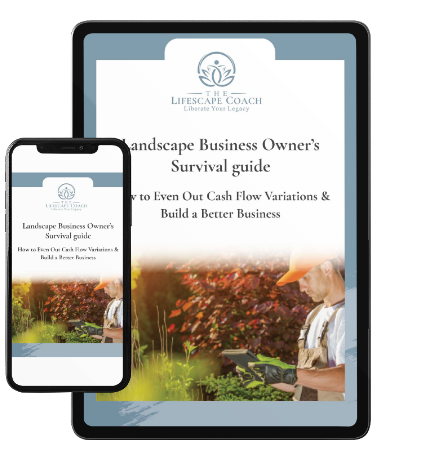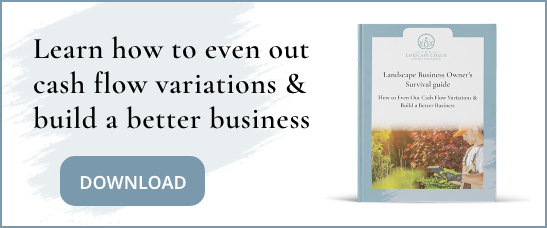Expert Advice to Establish a Landscape Business Pricing Strategy
Here is a question I hear over and over again: “Our pricing is all over the place, how do I set landscape service prices and stick to them?” Confusion about pricing strategy is commonplace in many service industries and that’s certainly true in the field of landscape. Too many business owners simply do not know how to set the price for their services and spend a lot of time struggling with it.
The root of the problem for many startup landscape companies is that the owners think in terms of working for an hourly wage. This is no surprise because non-employer businesses (that is, companies that don’t have employees) make up about 80 percent of US companies. Most of these mom and pop organizations are owned and operated by individuals who were employed in their field before they became business owners themselves. Used to the concept of an hourly wage, many simply increased that hourly wage for themselves once they went into business (“I used to make $20 an hour working for somebody else – I’m gonna charge $40 an hour for myself!”) and got stuck in that business model. Sadly, this is not a positive landscape business pricing strategy that can set you on a path to real success and financial stability.
A big problem with this strategy is that it doesn’t take into account all of the costs associated with the work they’re doing. In fact, there are many factors that go into setting a rate for your work. Things such as wages and associated labor burden (what it costs to maintain employees, not just pay them). It’s important to consider all the costs associated with delivering your service or product, as well as your market and competitor pricing.
Once you know exactly what it costs you to deliver your product or service, you have several different pricing options:
Market Penetration Pricing
This model calls for setting your prices lower than your competitors to lure clients away from them and dominate the market. Because the main reason for adopting this pricing policy is to boost market share over profits, there is little or no margin in it. It’s typically used early in the lifecycle of a product, service, or company to get established.
Economy Pricing
This pricing strategy provides a razor-thin profit margin based on volume. In other words, you need to push out a lot of work in a day to actually make money. That kind of volume doesn’t allow for any frills – no personalization or extra touches that would help build client loyalty and steady, return business. Basically, it gets the job done and moves on. Low price is what the prospect values and he or she is not susceptible to up-selling or buying any bells and whistles that can earn you more money.
Service Pricing
This pricing model is based on delivering a service package that promises a result. Prospects want solutions to a problem and some personalized attention to go with those solutions. Rather than delivering quick, single stream service, there is some bundling of a few services to make full solutions available. Price is now related to the bundle rather than the single service allowing for some added profit to you and added value to the client. This strategy allows for the building of relationships and an eventual step-up to Premium pricing.
Premium Pricing
This is where real value – and profitability – kick in. Pricing is set at a higher level than your competitors, but there is a buyer’s perception of high value (they’re going to get a bigger bang for the buck), resulting from brand recognition (you’ve invested in marketing and outreach in various forms so your visibility in the market is relatively high) and there is a sense of status connected with your service. In turn, it requires you to provide a very high level of client care and interest in the overall buyer experience. In short, your clients will gladly spend more money because they see the value in it and you make it worthwhile.
Keep in mind, people don’t want to be sold and they don’t want to overpay. If you’re going to charge more – and you should – you need to be sure to match the right prospect to the exceptional service you’re offering and set your pricing to reflect that added value. It should all align. And it goes both ways – you can’t charge a premium price for cut-rate service and you shouldn’t undercharge for premium service. Neither will work in the long run.
 If you’re working on a volume model, sell and produce as much as possible in the shortest amount of time using Market Penetration pricing. Remember, you’re trying to get as many clients as you can in a short amount of time. You’re pricing low to get people in the door so you can prove yourself. Be careful, though -- this is a tricky strategy that traps many small businesses in a vicious cycle of too much work for too little income. Once you’ve proven yourself you should be raising your rates to an Economy Pricing level so that you can keep these price-conscious consumers without losing out on revenue and profit in the long term.
If you’re working on a volume model, sell and produce as much as possible in the shortest amount of time using Market Penetration pricing. Remember, you’re trying to get as many clients as you can in a short amount of time. You’re pricing low to get people in the door so you can prove yourself. Be careful, though -- this is a tricky strategy that traps many small businesses in a vicious cycle of too much work for too little income. Once you’ve proven yourself you should be raising your rates to an Economy Pricing level so that you can keep these price-conscious consumers without losing out on revenue and profit in the long term.
Working on a solution model where people want a specific result with options requires Service pricing. This gives you the ability to move away from unit prices and into service delivery investments. Taken to the next level, the solution model becomes highly personal and customized enabling you to charge Premium pricing. At this level your clientele wants the best of everything. They want YOU because you’re an expert and have a reputation of being the best. Your “unique selling proposition” is very strong and they don’t believe they can get what you deliver anywhere else.
How I stopped giving away ideas and started making more money
I remember when I decided to charge for initial consultations and how that completely changed how I did business. I had been in the industry for about 15 years and I was feeling pretty tired of giving away ideas at these initial meetings. As a designer, contractor, and gardener, I could come up with ideas and answers really quickly but began to feel that those ideas and solutions weren’t valued or, worse, they were simply being “stolen.”
I was spending hours and hours each week meeting prospects and trying to strike a balance between giving away all my ideas and saving some for the actual sale. By the end of the week, I was feeling thoroughly “used up.”
So I thought, “why don’t I charge for the meeting and then just bring super-high value to the homeowner by really sharing ALL my ideas and solutions without caring whether they hired me or not?”
Well, it worked! I started charging a consultation fee and I became so satisfied with the practice of meeting homeowners to talk about their landscapes that I actually started selling more jobs! I was there fully for THEM and they could feel it. I was able to say, “This time is all about you -- ask me anything and we’ll see if we can come up with a solution in the time we have.” They felt truly heard and helped. It turned out to be a real win/win situation – I got the business and they got the value.
I will leave you with this: You will always deliver the best results when you feel valued, appreciated and well-compensated for your efforts and expertise. That is the road to long-term success and profitability.
Image copyright: 123RF Stock Photo
Landscape Business Owners Survival Guide



